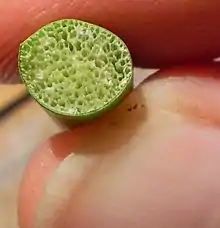Aerenchyma
Aerenchyma is a spongy tissue that forms spaces or air channels in the leaves, stems and roots of some plants, which allows exchange of gases between the shoot and the root.[1] The channels of air-filled cavities (see image to right) provide a low-resistance internal pathway for the exchange of gases such as oxygen and ethylene between the plant above the water and the submerged tissues. Aerenchyma is also widespread in aquatic and wetland plants which must grow in hypoxic soils.[2][3]

Aerenchyma formation and hypoxia
When soil is flooded, hypoxia develops, as soil microorganisms consume oxygen faster than diffusion occurs. The presence of hypoxic soils is one of the defining characteristics of wetlands. Many wetland plants possess aerenchyma, and in some, such as water-lilies, there is mass flow of atmospheric air through leaves and rhizomes.[4] There are many other chemical consequences of hypoxia. For example, nitrification is inhibited as low oxygen occurs and toxic compounds are formed, as anaerobic bacteria use nitrate, manganese, and sulfate as alternative electron acceptors.[5] The reduction-oxidation potential of the rhizhosphere decreases and metal ions such as iron and manganese precipitate. Aerenchyma is a modification of the parenchyma.
In general, low oxygen stimulates trees and plants to produce ethylene.[6] From New Latin, dating back to 1895–1900; see origin at aer-, parenchyma
Advantages
The large air-filled cavities provide a low-resistance internal pathway for the exchange of gases between the plant organs above the water and the submerged tissues. This allows plants to grow without incurring the metabolic costs of anaerobic respiration.[7] Some of the oxygen transported through the aerenchyma leaks through root pores into the surrounding soil. The resulting small rhizosphere of oxygenated soil around individual roots support microorganisms that prevent the influx of potentially toxic soil components such as sulfide, iron, and manganese.
References
- Sculthorpe, C. D. 1967. The Biology of Aquatic Vascular Plants. Reprinted 1985 Edward Arnold, by London.
- Keddy, P.A. 2010. Wetland Ecology: Principles and Conservation (2nd edition). Cambridge University Press, Cambridge, UK. 497 p
- Kozlowski, T. T. (ed.) 1984. Flooding and Plant Growth. Orlando, FL: Academic Press.
- Dacey, J. W. H. 1980. Internal winds in water lilies: an adaptation for life in anaerobic sediments. Science 210: 1017–19.
- Patrick, W. H., Jr. and Reddy, C. N. 1978. Chemical changes in rice soils. In Soils and Rice, pp. 361–79. Los Ban˜ os, Philippines: International Rice Research Institute.
- Kozlowski, T. T. (ed.) 1984. Flooding and Plant Growth. Orlando, FL: Academic Press.
- Laing, H. E. 1940. Respiration of the rhizomes of Nuphar advenum and other water plants. American Journal of Botany 27: 574–81.
| Wikimedia Commons has media related to Aerenchyma. |